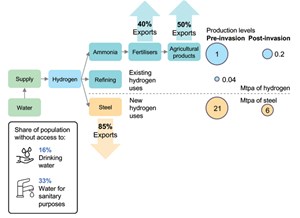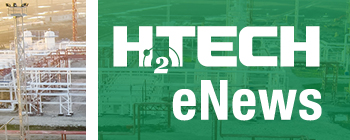Articles
Rebuilding with H2: Ukraine’s opportunity amidst uncertainty in the global H2 economy
Editorial Comment
TYLER CAMPBELL, Managing Editor
The uncertainty within the hydrogen (H2) market continues as various regions approach sustainability in different ways, while others disregard it altogether. Europe has continued its efforts to incorporate H2 into its energy mix despite setbacks, with several planned projects being postponed or scrapped. Ukraine—a nation that has faced adversity and invasion over the past few years—has an opportunity to rebuild its energy infrastructure with H2 at the core. Of course, this will take time and capital.
Prior to the war with Russia, 40% of Ukraine’s fertilizer output, 46% of its agricultural output and 67% of steel were exported. According to the International Energy Agency (IEA), fertilizers were Ukraine’s largest source of H2 demand, consuming 1 metric million tons per year (MMtpy); however, output has fallen by about 80%.1 One of the country’s largest ammonia production facilities (Severodonetsk) was severely damaged and taken out of operation in 2022, heavily contributing to Ukraine’s decline in fertilizer output.
Ukraine’s steel production has also decreased by more than 60% since Russia’s invasion.1 H2 can be used in steel production, primarily via the direct reduced iron (DRI) process. This presents an opportunity for the nation to use low-emissions H2 to restart steel production in a more sustainable manner. Steel represented about 10% of the nation’s gross domestic product (GDP) and about 25% of exports but was responsible for 15% of Ukraine’s carbon dioxide (CO2) emissions. Decarbonizing steel production could greatly reduce the country's carbon footprint (FIG. 1).
Unfortunately, Ukraine’s water supply has also been affected by the war, which negatively impacts potential H2 production. Almost one-third of the national water resources (55 Bm3) is held in reservoirs, and in June 2023, the Kakhovka reservoir was destroyed. The reservoir had a capacity of 18 Bm3 and the attack resulted in it losing 80% of its volume. This affects not only the country’s drinking water but a crucial ingredient in H2 production.
The H2 economy remains uncertain, relying heavily on regional strategies and politics. While most of Europe pushes forward, nations like Ukraine find themselves at a crucial crossroads. For Ukraine, leveraging low-carbon H2 in key sectors, such as steel and fertilizer production, could reignite economic growth and contribute to global CO2 reduction goals. H2T
LITERATURE CITED
1 IEA, “Unlocking Ukraine’s hydrogen opportunity: A roadmap,” March 2025, online: https://iea.blob.core.windows.net/assets/c44e4ec9-784f-48dc-945b-459416d3acd2/UnlockingUkrainesHydrogenOpportunity_ARoadmap.pdf


